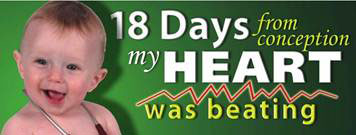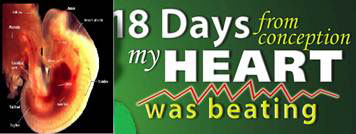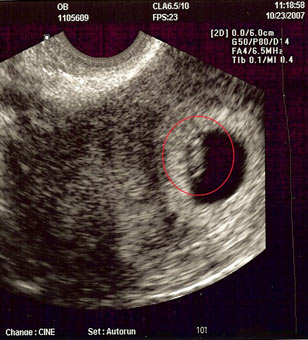The most determined abortion opponents will say or do almost anything in the service of their cause: Distortion, deception, manipulation, intimidation, even murder. If you were trying to save millions of innocent children from butchers, wouldn’t you do the same? Come on: Do you really question the ethics of people who used any means at their disposal to save lives during the Rwandan genocide? As much as we hate to admit it, we all acknowledge situations where the ends justify the means – where moral and ethical priorities compete with each other and we have to choose which one is the higher good. A threat to our own life or the life of an innocent person tends to trump all else.
Abortion opponents may be driven by Iron Age sexual scripts, but they are advancing their cause primarily by appealing to universal, secular and – ironically – progressive – ethical principles. If history has a moral arc, the curve has to do with one simple question: Who counts as a person? Who deserves autonomy and opportunity and freedom from unnecessary suffering? Who merits our compassion or respect? In other words, who is morally relevant?
America’s history is one in which generations of our ancestors have asked and answered this question. Time and again they fought and won rights and dignity for those who previously were considered unworthy: the landless poor, religious minorities, black slaves, workers, First Nations, women. In doing so, they were saying, “These, too, are persons – and fully deserving of life, liberty and the pursuit of happiness.” Today, when activists fight for rights for gays; immigrants; animals; and, once again, women, they are saying the same thing. Battles over who counts as a person have defined the progressive movement for the last two hundred years.
That is why the pro-life crowd made the brilliant chess move of staking out the word “personhood.” Personhood transforms a fetus from a what to a who. It activates moral instincts and reasoning that have been shaped by centuries of conflict and conversation – along with related ethical and legal codes.
We have powerful, even sacred, obligations to other persons and we all know it. We humans are social animals, and in order to flourish, we have to be able to live in cooperative communities with each other. This simple fact explains why virtues such as compassion, generosity and honesty – together with some form of the Golden Rule – lie at the heart of virtually every wisdom tradition, whether secular or religious. Our ability to care about each other, to treat the well-being of others as if it actually mattered and even to feel it at a gut level, is what has allowed us to build families, communities, cities and civilizations. (Tangentially, this is also why corporations have demanded the rights of personhood for economic entities, and religious authorities have demanded the protections of personhood for ideologies – but that is another story.) If a fertilized egg is truly a person, then all else follows.
Conservatives get this deeply. It’s no accident that they always refer to a blastocyst, embryo or fetus as a baby. Some conservative churches feed guilt and trauma in women who have had abortions and then offer them recovery groups. In such groups, women may hold and speak to dolls with the size and look of infants rather than the peanut sized, lizard-like entity they most likely aborted. Fetus-as-baby indoctrination starts early. I once took my niece to the Children’s Museum of Phoenix, an ostensibly secular museum of science and history. The museum had a display on fetal development that clearly had been funded or designed by someone with an anti-abortion agenda. After a beautiful image of an egg being fertilized, the developmental sequence skipped ahead to the earliest stage at which a fetus looks both human and appealing and then proceeded from there.
Two of the most powerful weapons in the Conservative arsenal – and both are radical game changers – have been virtually ignored by reproductive rights strategists: ultrasound and fetal photography. Thirty years ago, pregnancy was a black box. Sperm went in; babies came out. Today a pregnant mother is given beautiful books of fetal images so that she can track and marvel at the process of development going on inside her. Doctors’ visits often include an ultrasound that is ooohed over by a pair of curious parents-to-be. Part of what made my own abortion painful was that my husband and I had seen an image of our developing fetus, our child-to-be and it was thrilling!
We humans rely on vision more than any of our other senses and visuals alone can evoke emotional responses and moral instincts that are designed to help us relate to persons. Young infants orient to black spots and lines on paper that are arranged like eyes and mouths. Children cling to stuffed animals that don’t taste, sound or smell like persons. They invent personalities for hard, plastic dolls and become distressed if someone treats a doll badly.
The power of visual images is why “heartbeat” billboards look like this:

rather than this – perhaps with a same-sized picture of a dried pea for scale:

(Biologist PZ Myers suggested that the billboards should have another line of text: “I also had a tail.”) The Internet is full of pictures that appear to be remains of late-term abortions – even though the legal battles at this point are about microscopic spheres; gooey, little blobs; and things that look like mutant newts. That is because anti-abortion images are selected to trigger the same reflexive caring that gets tapped by those big-eyed children in ads for Care International or its Evangelical analog World Vision, and the same horror we would feel at images of them dead. (You’ll notice my analogies did the opposite.) The goal is not to have us think; in fact, it is to have us not think – to bypass reason and evoke a feeling that a human blastocyst or embryo or fetus is a helpless little somebody who needs our protection.
The irony, of course, is that a fertilized egg is not a person in any traditional or meaningful sense. Nature aborts as many as 80 percent of them, most before they implant, and nobody gives it a second thought. Conversely, the long litany of struggles I mentioned to gain person-rights for slaves, natives, coal miners, and others had nothing to do with human protoplasm and everything to do with the fact that the parties in question had the attributes and wanted the rights of personhood. They could feel pleasure and pain. They had preferences and intentions. They could value their moment to moment experience and dreams of the future.
These qualities of personhood exist to a greater or lesser degree in all sentient beings, but most fully, on this planet at least, in conscious, self-aware humans. Because we are earthbound and self-centered, we associate personhood with humanity. However, at our best, we are able to think beyond our own kin. Science fiction movies like “Blade Runner” and “District 9” base their story lines around the poignant personhood of intelligent beings who lack human DNA and yet have the capacity to love and to love being alive. Recently, scholars who have spent their lives among chimps and cetaceans respectively have suggested that such self-aware and intelligent creatures should have legal personhood rights that match the ways in which they experience the world. The Institute for Ethics and Emerging Technologies has launched a program called “The Rights of Non-Human Persons.”
One of the challenges of bringing real philosophical and psychological personhood into the abortion debate is that it opens questions that feel morally dicey. Personhood exists on a continuum even in post-born humans. Terri Schiavo, the person, was gone long before her body was unplugged. A baby can be born with an empty cranium, a condition called anencephaly, with no hope of ever developing into a person. But we humans have a terrible track record of deciding that people with one or another set of qualities don’t count and then treating them with cruelty. And so we all – left and right – are rightly wary of talking about such boundary cases.
Abortion rights supporters have refused to acknowledge a related reality: personhood exists on a continuum in utero as well. A fertilized egg has none of the attributes of personhood and, in fact, a fetus can develop a beating heart and a distinctively human shape before having neural connections that would allow the same level of consciousness as a snail. And, yet, the first flickers of sentience emerge long before birth. A fertilized egg is just life, a full human blueprint with a 20 percent chance of becoming a baby. At the other end of pregnancy, a newborn can feel sensations such as pleasure and pain, hunger, cold and attachment. But how do we navigate backward from infancy to some hazy boundary between personhood and mere life? The Roe v. Wade opinion wrestled with these complexities and attempted to find a balance point. And, yet, much of the conversation since on the pro-choice side has simply taken some form of hands off my body!
Acquaintances have pointed out that an argument can be made for abortion rights regardless of fetal personhood status. Even if a fetus were fully a person, in no other arena do we force someone to act as involuntary life support (or as a blood donor or organ donor) for another being. In all situations except pregnancy, such donations are voluntary. Once again, fiction helps us to explore the ethics of involuntary donation: “My Sister’s Keeper,” “House of the Scorpion,” “Never Let Me Go.” Involuntary donors are second-class persona non grata, as are involuntary incubators such as those in “The Handmaiden’s Tale.” As stories like these illustrate, the conditions of involuntary donation are incompatible with basic human decency. This argument about human rights might be a legal or ethical trump card in the abstract, but in the court of public opinion, libertarian arguments fail when pitted against the idea of protecting children from harm. We can’t get away from addressing the question pro-life groups have posed: What qualities transform a life into a person?
Abortion foes are confident they can win person rights for the pre-born. If so, it will be in part because progressives have failed to engage the public in a credible moral conversation about one of our most sacred concepts: what it means to be person. It will also be because we have failed to go public with the one thing that has the power to trump bogus personhood claims: pictures of real persons, including women, men and children, whose lives have been transformed by reproductive technologies and choices. Our communities include marriages that stayed loving because a couple was able to make wise, thoughtful decisions about childbearing; mothers who would have died of pregnancy and children who exist only because their parents were able to terminate unhealthy or ill-timed conception. Why are they invisible?
Images spattered across the Internet and the country by abortion foes are not only visual, they are visceral, sometimes literally, as in pictures of viscera mingled with partially developed limbs. Offensive? No problem. They are fighting for something they see as fundamentally sacred. Are we? If so, we need to get visceral, too. Are unwanted children more likely to be abused? Let’s see the doe-eyed advertisements. Should an incest victim have to stay pregnant or be excommunicated? Post mug shots of the bastard who did it and the supercilious priest. Can accidental pregnancy cause depression or suicide? Obviously, but we don’t hear about it. Can fetal anomalies be devastating? Let’s see the gory close-ups. The yuck factor works on our side, too.
Reproductive rights leaders are worried about an intensity gap between Millennials who support and oppose abortion. Frankly, we deserve it. For the past twenty years, while pro-choice advocates muttered about statistics and privacy and tested make-nice language like “nobody is pro-abortion” or “let’s make it safe, legal and rare,” anti-choice advocates have created a gut-level aversion to abortion in a whole generation of young Americans. Most Millennials have experienced the billboards. What they haven’t experienced is the gut-wrenching stories of real people – people they know and love – whose lives are more whole because they were able to choose. If you want to change the game, get out of the closet with your abortion story, or your mother’s story, or your grandmother’s story. Get up your nerve by watching videos or reading stories posted at the One in Three Campaign. Some – albeit few and far between – pro-choice efforts besides the One in Three Campaign have encouraged abortion stories and the humanization of women who’ve undergone abortions, such as Ms. Magazine’s “We Had Abortions” campaign. Our sometimes beautiful, sometimes heartbreaking, sometimes proud, sometimes ordinary stories are the stuff of real personhood.
If abortion foes want to call themselves Pro-life, let them. Mere life is uniformly sacred to almost no one; even those who most arrogantly see themselves on a God-given pro-life mission, place little value on the life of a mouse or spider. Many of them appear to place little value on the 30,000 children who die daily of starvation or the 343,000 women who die every year from pregnancy. Ultimately, “Pro-life” is a weak, now-tainted label, just barely stronger than “Pro-choice.” But if we don’t win on what it means to be a living, breathing person, one who can feel joy and pain and even make thoughtful decisions about when to bring children into this world, we have ceded the moral underpinnings of the whole progressive enterprise.
Truthout Is Preparing to Meet Trump’s Agenda With Resistance at Every Turn
Dear Truthout Community,
If you feel rage, despondency, confusion and deep fear today, you are not alone. We’re feeling it too. We are heartsick. Facing down Trump’s fascist agenda, we are desperately worried about the most vulnerable people among us, including our loved ones and everyone in the Truthout community, and our minds are racing a million miles a minute to try to map out all that needs to be done.
We must give ourselves space to grieve and feel our fear, feel our rage, and keep in the forefront of our mind the stark truth that millions of real human lives are on the line. And simultaneously, we’ve got to get to work, take stock of our resources, and prepare to throw ourselves full force into the movement.
Journalism is a linchpin of that movement. Even as we are reeling, we’re summoning up all the energy we can to face down what’s coming, because we know that one of the sharpest weapons against fascism is publishing the truth.
There are many terrifying planks to the Trump agenda, and we plan to devote ourselves to reporting thoroughly on each one and, crucially, covering the movements resisting them. We also recognize that Trump is a dire threat to journalism itself, and that we must take this seriously from the outset.
After the election, the four of us sat down to have some hard but necessary conversations about Truthout under a Trump presidency. How would we defend our publication from an avalanche of far right lawsuits that seek to bankrupt us? How would we keep our reporters safe if they need to cover outbreaks of political violence, or if they are targeted by authorities? How will we urgently produce the practical analysis, tools and movement coverage that you need right now — breaking through our normal routines to meet a terrifying moment in ways that best serve you?
It will be a tough, scary four years to produce social justice-driven journalism. We need to deliver news, strategy, liberatory ideas, tools and movement-sparking solutions with a force that we never have had to before. And at the same time, we desperately need to protect our ability to do so.
We know this is such a painful moment and donations may understandably be the last thing on your mind. But we must ask for your support, which is needed in a new and urgent way.
We promise we will kick into an even higher gear to give you truthful news that cuts against the disinformation and vitriol and hate and violence. We promise to publish analyses that will serve the needs of the movements we all rely on to survive the next four years, and even build for the future. We promise to be responsive, to recognize you as members of our community with a vital stake and voice in this work.
Please dig deep if you can, but a donation of any amount will be a truly meaningful and tangible action in this cataclysmic historical moment.
We’re with you. Let’s do all we can to move forward together.
With love, rage, and solidarity,
Maya, Negin, Saima, and Ziggy
